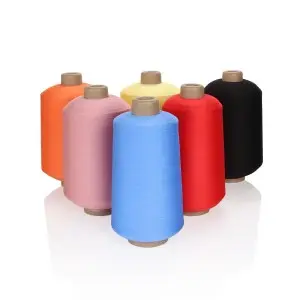Nylon thermal melt yarn is produced by spinning low melting point polyamide. Low melting point polyamide is a modified polyester. Nylon hot melt yarn produced by spinning low melting point polyamide has the advantages of low melting point, high thermal bonding strength and stable physical and chemical properties.
Performance characteristics of nylon thermal fuse:
1. Low melting point, the melting point of nylon thermal fuse is as low as 90C.
2. Good wear resistance. The wear resistance of polyamide fiber is the best among all textile fibers.
3. High breaking strength. The breaking strength of polyamide long fiber for textile purposes is 5.0~6.4g/d.
4. Good dyeability. The dyeability of polyamide fiber is more difficult than that of natural fiber, but it is still easier to dye than other synthetic fibers. It is usually dyed with acid dyes.
Polyester hot-melt yarn is mixed with conventional polyester or other fibers to produce non-woven fabrics or knitted or woven into thermally bonded fiber products, which have the characteristics of soft hand, high strength, washability, crispness, easy care, and no environmental pollution.
Purpose of polyester hot melt yarn: Mainly used for thermal bonding, used in Bondi thread weaving, high-strength webbing, wool carpets, cushions, automobile linings and other industries.
1. high strength. The strength of short fiber is 2.6~5.7cN/dtex, and the strength of high-strength fiber is 5.6~8.0cN/dtex. Due to its low hygroscopicity, its wet strength is basically the same as its dry strength. The impact resistance is 4 times higher than nylon and 20 times higher than viscose fiber.
2. Good elasticity. The elasticity is close to that of wool. When stretched by 5% to 6%, it can almost completely recover. The wrinkle resistance is better than other fibers, that is, the fabric does not wrinkle and has good dimensional stability. The elastic modulus is 22~141cN/dtex, which is 2~3 times higher than nylon. .Polyester fabric has high strength and elastic recovery ability, so it is durable, wrinkle-resistant and does not need to be ironed.
3. Heat-resistant polyester is made through melt spinning. The formed fiber can be heated and melted again, and it is a thermoplastic fiber. The melting point of polyester is relatively high, but the specific heat capacity and thermal conductivity are small, so the heat resistance and insulation of polyester fiber are higher. It is the best among synthetic fibers.
4. Good thermoplasticity but poor melt resistance. Due to the smooth surface of polyester and the tight arrangement of internal molecules, polyester is the most heat-resistant fabric among synthetic fabrics. It is thermoplastic and can be made into pleated skirts with long-lasting pleats. At the same time, polyester fabric has poor melt resistance and can easily form holes when exposed to soot, sparks, etc. Therefore, you should try to avoid contact with cigarette butts, sparks, etc. when wearing it.5. Good wear resistance. The wear resistance is second only to nylon, which has the best wear resistance, and is better than other natural fibers and synthetic fibers.
Polyester hot melt yarn is produced by spinning low melting point polyester chips. Low melting point polyester chips are a modified polyester prepared by adding third and fourth modified monomers to conventional polyester. Polyester hot-melt yarn produced by spinning low-melting polyester chips has the advantages of low melting point, high thermal bonding strength and stable physical and chemical properties. Compared with polypropylene and polyamide fibers, the latter will flow and deform after melting and cannot return to their original shape after cooling, so they have great thermal shrinkage, while the thermal shrinkage of low-melting point fibers in their free state is only 5%. Therefore, it can replace polypropylene and polyamide hot melt adhesives in some fields, and at the same time has its own unique application fields. It is widely used in hot air method shoe upper manufacturing, yarn manufacturing, clothing manufacturing, clothing seamless locks, soft gauze vertical curtains and other textile fields.
Post time: Jun-24-2024

